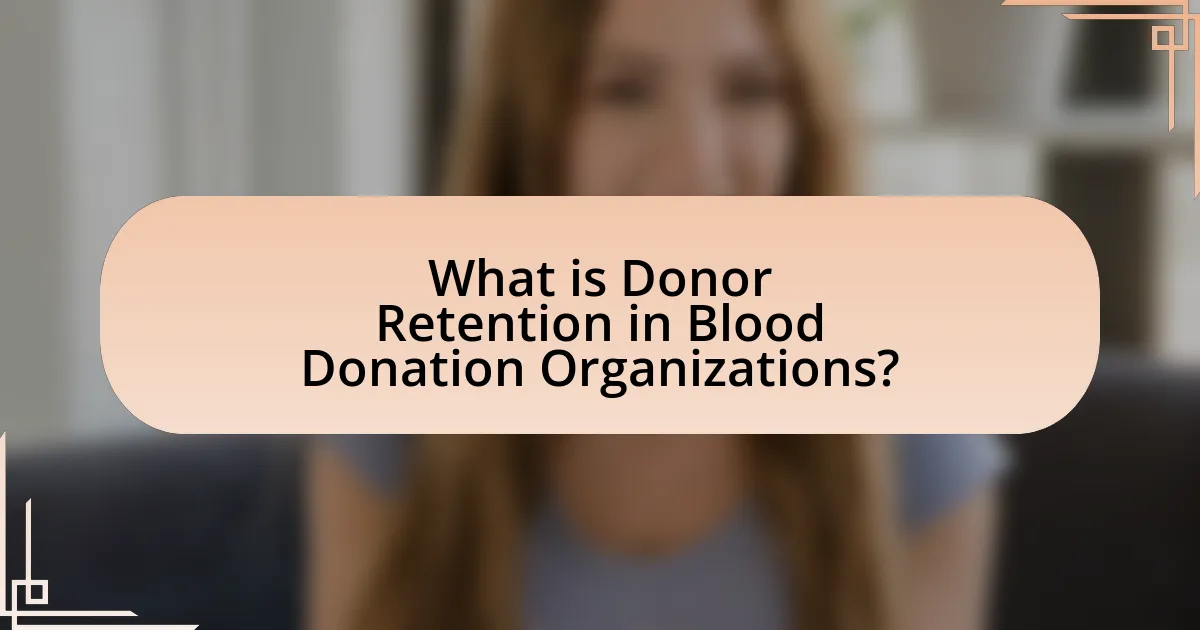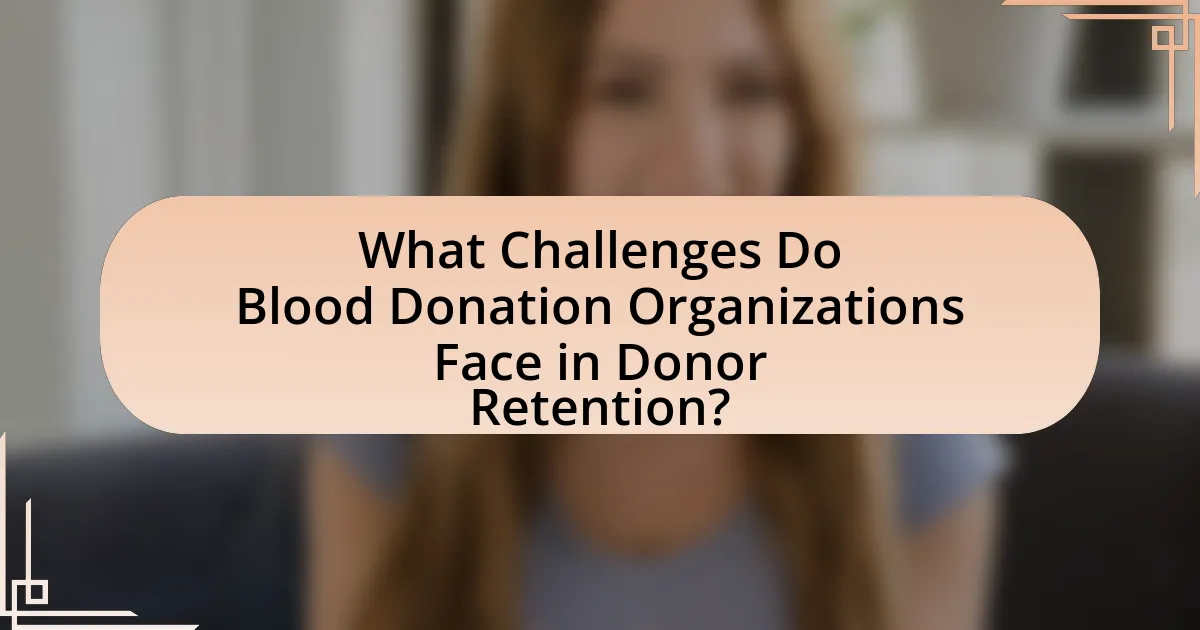Donor retention in blood donation organizations is the ability to keep existing donors engaged and returning for future donations, which is essential for maintaining a stable blood supply. High retention rates are critical as repeat donors contribute significantly more than first-time donors, with studies indicating they provide about 80% of collected blood. The article explores the importance of donor retention, its impact on blood supply and community health, key metrics for measuring retention, best practices for enhancing donor engagement, and the challenges organizations face in maintaining donor loyalty. Effective strategies include personalized communication, recognition programs, and addressing donor concerns to foster long-term relationships and ensure a reliable blood supply.
What is Donor Retention in Blood Donation Organizations?

Donor retention in blood donation organizations refers to the ability of these organizations to keep existing donors engaged and returning for future donations. High donor retention rates are crucial for maintaining a stable blood supply, as studies indicate that repeat donors contribute significantly more than first-time donors. For instance, the American Red Cross reports that repeat donors provide about 80% of the blood collected, highlighting the importance of strategies aimed at fostering long-term donor relationships. Effective donor retention practices include personalized communication, recognition programs, and follow-up engagement, which collectively enhance donor loyalty and commitment to regular donations.
Why is Donor Retention Important for Blood Donation Organizations?
Donor retention is crucial for blood donation organizations because it ensures a stable and reliable supply of blood products. Retaining donors reduces recruitment costs, as acquiring new donors is significantly more expensive than keeping existing ones; studies indicate that it can cost up to five times more to recruit a new donor than to retain an existing one. Furthermore, consistent donors are more likely to donate regularly, which helps maintain adequate blood inventory levels necessary for patient care and emergency situations. This reliability is essential, as blood donation organizations often face fluctuating demand and need to ensure that they can meet the needs of hospitals and patients effectively.
What impact does donor retention have on blood supply?
Donor retention significantly impacts blood supply by ensuring a consistent and reliable source of donations. High donor retention rates lead to a stable inventory of blood products, which is crucial for meeting the demands of hospitals and patients. According to the American Red Cross, maintaining a donor base where individuals return to donate regularly can increase the overall blood supply by up to 20%. This stability helps mitigate shortages during emergencies and seasonal fluctuations in donations, thereby enhancing the overall efficiency of blood donation organizations.
How does donor retention influence community health?
Donor retention significantly influences community health by ensuring a stable and sufficient blood supply for medical needs. When blood donation organizations maintain high donor retention rates, they can consistently meet the demand for blood products, which is crucial for surgeries, trauma care, and chronic illness management. For instance, studies show that a 10% increase in donor retention can lead to a 15% increase in available blood supply, directly impacting patient outcomes and reducing wait times for critical procedures. This reliable access to blood resources enhances overall community health by improving emergency response capabilities and supporting healthcare systems effectively.
What are the Key Metrics for Measuring Donor Retention?
Key metrics for measuring donor retention include the donor retention rate, average donation frequency, and lifetime value of a donor. The donor retention rate quantifies the percentage of donors who continue to give over a specific period, typically calculated annually. For example, a retention rate of 60% indicates that 60 out of 100 donors from the previous year made another donation. Average donation frequency measures how often donors contribute within a given timeframe, providing insight into donor engagement. Lastly, the lifetime value of a donor estimates the total revenue a donor is expected to generate throughout their relationship with the organization, which helps in assessing the long-term impact of retention strategies. These metrics collectively provide a comprehensive view of donor loyalty and the effectiveness of retention efforts.
How is donor retention rate calculated?
The donor retention rate is calculated by dividing the number of donors who made a subsequent donation in a given period by the total number of donors in the previous period, then multiplying by 100 to express it as a percentage. For example, if 200 donors donated in the previous year and 150 of those donors donated again in the current year, the calculation would be (150 / 200) * 100, resulting in a 75% donor retention rate. This metric is crucial for blood donation organizations as it reflects the effectiveness of their engagement strategies and the loyalty of their donor base.
What other metrics should organizations track alongside donor retention?
Organizations should track donor acquisition rates alongside donor retention. Monitoring donor acquisition rates provides insight into how effectively an organization is attracting new donors, which is crucial for overall growth and sustainability. According to the Association of Fundraising Professionals, a healthy donor acquisition strategy can lead to a more robust donor base, which complements retention efforts. Additionally, tracking donor lifetime value helps organizations understand the long-term financial impact of their donors, enabling better resource allocation and strategic planning. Research indicates that organizations focusing on both acquisition and retention can increase their overall fundraising effectiveness by up to 30%.
What Best Practices Can Enhance Donor Retention?

To enhance donor retention, blood donation organizations should implement personalized communication strategies. Research indicates that personalized outreach, such as tailored thank-you messages and updates on the impact of donations, significantly increases donor engagement and loyalty. For instance, a study by the Association of Fundraising Professionals found that organizations that utilized personalized communication saw a 20% increase in donor retention rates. Additionally, establishing a donor recognition program can foster a sense of belonging and appreciation, further solidifying the relationship between donors and the organization.
How can Blood Donation Organizations Improve Communication with Donors?
Blood donation organizations can improve communication with donors by utilizing personalized messaging and leveraging multiple communication channels. Personalized communication, such as tailored emails or text messages that acknowledge individual donor contributions and preferences, has been shown to enhance donor engagement and retention. For instance, a study by the American Red Cross indicated that personalized outreach increased donor return rates by 20%. Additionally, employing various channels—such as social media, mobile apps, and traditional mail—ensures that organizations reach donors where they are most active, thereby increasing the likelihood of engagement. This multi-channel approach, combined with personalization, creates a more effective communication strategy that fosters stronger relationships with donors.
What communication channels are most effective for engaging donors?
Email and social media are the most effective communication channels for engaging donors. Research indicates that email marketing has an average return on investment of $42 for every dollar spent, making it a powerful tool for reaching and retaining donors. Additionally, social media platforms like Facebook and Instagram allow organizations to share impactful stories and updates, fostering a sense of community and encouraging donor interaction. According to a study by the Pew Research Center, 69% of adults in the U.S. use social media, highlighting its potential reach for donor engagement.
How often should organizations communicate with their donors?
Organizations should communicate with their donors at least monthly. Regular communication helps maintain donor engagement and fosters a sense of connection to the organization’s mission. Research indicates that consistent outreach, such as newsletters or updates, can significantly enhance donor retention rates, with studies showing that organizations that communicate frequently see a 20-30% increase in donor loyalty compared to those that communicate less often.
What Role Does Donor Recognition Play in Retention?
Donor recognition plays a crucial role in retention by fostering a sense of appreciation and belonging among donors. When organizations acknowledge and celebrate the contributions of their donors, it enhances the emotional connection and loyalty to the cause. Research indicates that personalized recognition can increase donor retention rates significantly; for instance, a study by the Association of Fundraising Professionals found that organizations that actively recognize their donors see a retention rate improvement of up to 20%. This demonstrates that effective donor recognition strategies not only validate the donor’s impact but also encourage continued support and engagement with the organization.
What are effective ways to recognize and appreciate donors?
Effective ways to recognize and appreciate donors include personalized thank-you notes, public acknowledgment in newsletters or social media, and hosting appreciation events. Personalized thank-you notes create a direct connection, showing donors that their contributions are valued. Public acknowledgment can enhance the donor’s reputation within the community, reinforcing their commitment to the cause. Hosting appreciation events allows organizations to engage with donors face-to-face, fostering a sense of belonging and community. Research indicates that organizations that actively recognize and appreciate their donors experience higher retention rates, as seen in studies conducted by the Association of Fundraising Professionals, which highlight the importance of donor recognition in maintaining long-term relationships.
How can personalized recognition impact donor loyalty?
Personalized recognition significantly enhances donor loyalty by making donors feel valued and appreciated for their contributions. When blood donation organizations acknowledge individual donors through tailored communications, such as personalized thank-you notes or recognition events, it fosters a sense of belonging and connection. Research indicates that organizations employing personalized recognition strategies experience higher retention rates; for instance, a study by the Association of Fundraising Professionals found that personalized engagement can increase donor retention by up to 40%. This demonstrates that when donors perceive their contributions as meaningful and recognized, they are more likely to continue their support over time.
What Challenges Do Blood Donation Organizations Face in Donor Retention?

Blood donation organizations face several challenges in donor retention, primarily including donor fatigue, lack of awareness about the need for regular donations, and inadequate follow-up communication. Donor fatigue occurs when individuals feel overwhelmed by frequent donation requests or perceive their contributions as less impactful over time. Research indicates that 60% of first-time donors do not return for a second donation, highlighting the importance of maintaining engagement. Additionally, many potential repeat donors are unaware of the ongoing need for blood, which can lead to decreased motivation to donate regularly. Effective follow-up communication is crucial; organizations that fail to thank donors or inform them about the impact of their contributions risk losing their commitment.
What Common Barriers Affect Donor Retention Rates?
Common barriers that affect donor retention rates include lack of communication, donor fatigue, and negative experiences during the donation process. Lack of communication can lead to donors feeling undervalued or disconnected from the organization, which diminishes their likelihood of returning. Donor fatigue occurs when individuals feel overwhelmed by frequent requests for donations, leading to decreased engagement. Negative experiences, such as long wait times or discomfort during the donation, can deter donors from returning. Research indicates that organizations that actively engage with donors and address these barriers see improved retention rates.
How do donor experiences influence their likelihood to return?
Donor experiences significantly influence their likelihood to return by shaping their perception of the donation process and the organization. Positive experiences, such as feeling appreciated, receiving timely communication, and experiencing a smooth donation process, increase the chances of donors returning. Research indicates that organizations that actively engage with donors post-donation, such as through thank-you messages or updates on the impact of their contributions, see higher retention rates. For instance, a study published in the Journal of Blood Medicine found that donors who reported a positive experience were 50% more likely to return for future donations compared to those who had a negative experience.
What external factors can impact donor retention?
External factors that can impact donor retention include economic conditions, social trends, and regulatory changes. Economic downturns can lead to reduced disposable income, causing potential donors to prioritize their finances over charitable contributions. Social trends, such as shifts in public perception about blood donation or competing charitable causes, can also influence an individual’s decision to continue donating. Additionally, changes in regulations regarding blood donation practices or health guidelines can affect donor willingness and retention rates. For instance, during the COVID-19 pandemic, many blood donation organizations experienced a decline in donor turnout due to health concerns and restrictions, highlighting how external health crises can significantly impact donor retention.
How Can Organizations Overcome These Challenges?
Organizations can overcome challenges in donor retention by implementing targeted communication strategies and enhancing donor engagement. By utilizing personalized outreach, such as tailored emails and follow-up calls, organizations can strengthen relationships with donors, making them feel valued and appreciated. Research indicates that organizations employing personalized communication see a 20% increase in donor retention rates. Additionally, creating a seamless donation experience through user-friendly scheduling and feedback mechanisms can significantly improve donor satisfaction and loyalty.
What strategies can be implemented to address donor concerns?
To address donor concerns, blood donation organizations can implement transparent communication strategies. This includes providing clear information about how donations are used, the impact on patients, and the safety measures in place during the donation process. Research indicates that transparency fosters trust; for instance, a study published in the Journal of Nonprofit & Public Sector Marketing found that organizations that effectively communicate their mission and impact experience higher donor retention rates. Additionally, organizations can establish feedback mechanisms, such as surveys or focus groups, to understand donor concerns and address them proactively, further enhancing donor engagement and satisfaction.
How can organizations adapt to changing donor demographics?
Organizations can adapt to changing donor demographics by implementing targeted communication strategies and diversifying their outreach efforts. By analyzing donor data, organizations can identify trends and preferences among different demographic groups, allowing them to tailor their messaging and engagement methods accordingly. For instance, younger donors may prefer digital communication channels, while older donors might respond better to traditional methods like direct mail. Research indicates that personalized communication increases donor retention rates, as it fosters a sense of connection and relevance. Additionally, organizations can enhance their appeal by offering flexible donation options and creating inclusive environments that resonate with diverse communities.
What Practical Tips Can Blood Donation Organizations Implement for Better Donor Retention?
Blood donation organizations can implement personalized communication strategies to enhance donor retention. By utilizing data analytics to segment donors based on their donation history and preferences, organizations can tailor messages that resonate with individual donors, increasing engagement. Research indicates that personalized outreach can improve donor retention rates by up to 20%. Additionally, organizations should establish a follow-up system that includes thank-you messages, donation reminders, and updates on how donations are making an impact, which fosters a sense of community and belonging among donors.